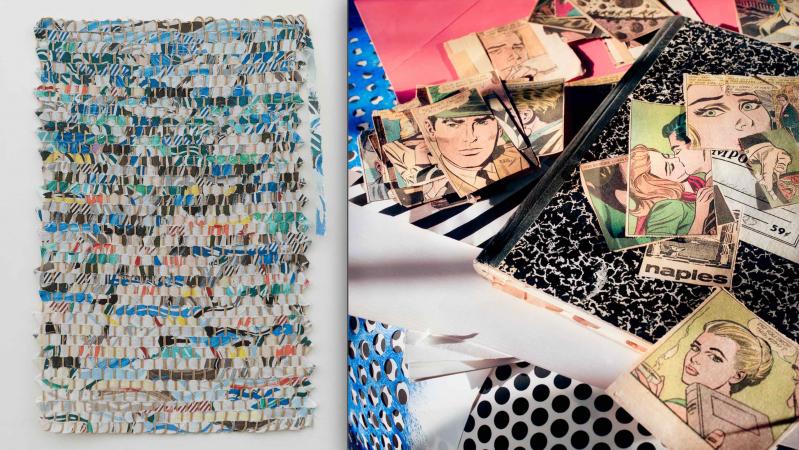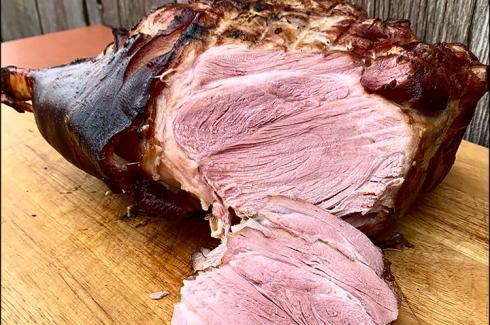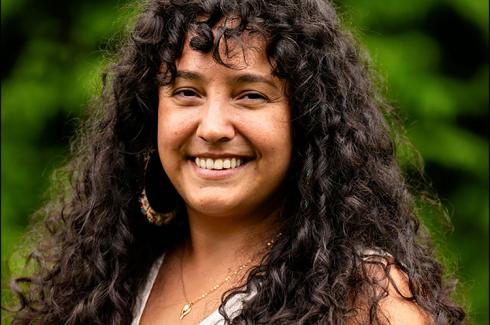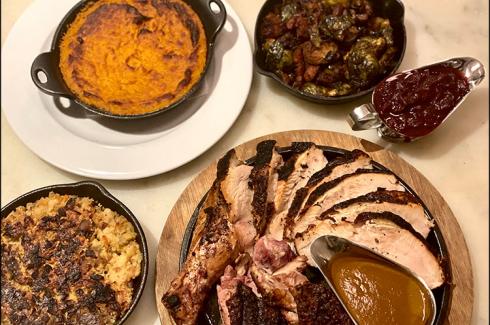Known for years primarily as a photographer with a high degree of commitment to her subjects, such as the architectural qualities of Robert Wilson's collection of chairs at the Watermill Center or Roy Lichtenstein's Southampton and New York studios, Laurie Lambrecht has changed her practice in more recent years to more hands-on approaches.
These have included embroidering embellishments on fabric printed with her photographs, knitting -- including cozy coverings for stones -- and other unique strategies to unite the outdoors with her studio practice. As engaging as these series have been, her latest works to have been shown (first at The Church in Sag Harbor this summer and now at the Drawing Room gallery in East Hampton) are an entirely new direction in her oeuvre.
"Weaving the Unraveled," now on view at the Drawing Room, is a collection of her latest tapestries, which employ photography and embroidery but add weaving into the mix to create unique works as well as visual puzzles that allude to famous and recognizable paintings. Although the strategy is new to the public, Ms. Lambrecht has been working in this vein since 2016.
The gallery display offers just enough to ponder while demonstrating the range of interpretations of the artist's processes. A full wall isolates the pieces made from reweaving photographs she took of works by well-known practitioners in modern and contemporary painting.
Unlike the "Pictures Generation," these appropriations are not literal or recognizable, at least not in a direct sense. Ms. Lambrecht prints the images on linen, cuts the print into strips, and then weaves them together with cotton or sisal on a hand loom. Rather than a result of random choices, her new compositions tend to have their own patterns and layered depth of color.
In some cases she appears to want us to decipher her source material, in others it might be impossible or she's playing with the medium in order to stump us. In a case like the Roy Lichtenstein piece hanging in the street-level window, it seems that the original artist's style might be so identifiable that it is impossible to miss it. Still, it is important to know what is happening here in order to figure it out.
Her resulting pieces in this vein, reworkings of Henri Matisse, Cy Twombly, Mary Heilmann, Sonia Delaunay, and the like, have their own intrinsic visual value. They can be appreciated without knowing their conceptual underpinnings. Yet having this information makes them all the more satisfying.
The remaining gallery walls show a blend of other recent explorations based on similar ideas with different outcomes. Ms. Lambrecht's series of "Tree Bark" embroidered tapestries from last year appear to be an extension and departure from her previous images of tree bark printed on linen and embroidered only in certain places. In the newer works, the embroidery dominates, creating texture and a slightly higher relief. She leaves the raw linen as a framing device, which sets off the needlework but also grounds the pieces, emphasizing their sources in nature.
There are hybrids, too. "Blue Sycamore," from 2021, is a cyanotype printed on linen that also looks reworked, and is embroidered only in spots, like her earlier bark works. Then there is a diptych of an embroidered print on linen with a woven piece on the left side. It is not quite clear, as there seem to be passages on the woven side that don't reflect what is seen on the right, but there is a suggestion that the woven piece might be made from the same print, now rewoven, as the embroidered side. Its title "Retroactive" suggests this in a cryptic way.
Others from this year take a maximalist approach, embedding reworked artworks, one by Joan Mitchell and the other by Pablo Picasso, into a printed fabric frame. These are called "Landscape/Paintings" and both apparently involve images taken in Wyoming, given the fuller titles of each. These landscapes are not sweeping vistas. Rather, they look like close-ups of natural phenomena, with a slight or greater abstract quality. They challenge us to think about our own perceptions, how nature can become abstract, how existing abstract patterns can be reimagined, making their sources seem less so or at least more recognizable in their original but still abstracted state.
If this seems like writing in circles, that could be what the artist is conjuring, that these classically abstract works can be recycled back to something reflective of nature and also turned into new works reflective of art history. As the gallery noted, Ms. Lambrecht was born and raised in Bridgehampton, where she still lives and works. The South Fork's "coastal landscape and woodland trails continue to inspire her imagery and creativity." In these works, she appears mindful of her environment as well as the rich artistic heritage always in evidence here.
In the front room of the gallery there are a few photographs from her series taken in Lichtenstein's studio. Seeing his source material all in a jumble might offer clues to some of the inspiration for these newer pieces. All are worth a trip to the gallery, which will have this exhibition on view through Oct. 30.




